Car
This article may be in need of reorganization to comply with Wikipedia's layout guidelines. The reason given is: messy layout. (July 2022) |
| Car | |
|---|---|
hybrids of the above | |
| Powered | Yes |
| Self-propelled | Yes |
| Wheels | 3–6, most often 4 |
| Axles | 2, less commonly 3 |
| Inventor | Carl Benz |
| Invented | 1886 |
A car, or an automobile, is a
French inventor Nicolas-Joseph Cugnot built the first steam-powered road vehicle in 1769, while French-born Swiss inventor François Isaac de Rivaz designed and constructed the first internal combustion-powered automobile in 1808. The modern car—a practical, marketable automobile for everyday use—was invented in 1886, when German inventor Carl Benz patented his Benz Patent-Motorwagen. Commercial cars became widely available during the 20th century. One of the first cars affordable by the masses was the 1908 Model T, an American car manufactured by the Ford Motor Company. Cars were rapidly adopted in the US, where they replaced horse-drawn carriages.[3] In Europe and other parts of the world, demand for automobiles did not increase until after World War II.[4] The car is considered an essential part of the developed economy.
Cars have controls for
There are costs and benefits to car use. The costs to the individual include acquiring the vehicle, interest payments (if the car is financed), repairs and
Etymology
The English word car is believed to originate from Latin carrus/carrum "wheeled vehicle" or (via Old North French) Middle English carre "two-wheeled cart", both of which in turn derive from Gaulish karros "chariot".[14][15] It originally referred to any wheeled horse-drawn vehicle, such as a cart, carriage, or wagon.[16][17]
"Motor car", attested from 1895, is the usual formal term in British English.[2] "Autocar", a variant likewise attested from 1895 and literally meaning "self-propelled car", is now considered archaic.[18] "Horseless carriage" is attested from 1895.[19]
"Automobile", a
History
)
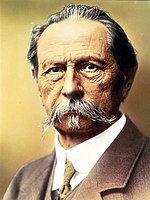


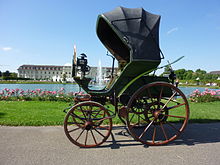
The first steam-powered vehicle was designed by
The development of external combustion (steam) engines is detailed as part of the history of the car but often treated separately from the development of true cars. A variety of steam-powered road vehicles were used during the first part of the 19th century, including
In 1807,
In November 1881, French inventor Gustave Trouvé demonstrated a three-wheeled car powered by electricity at the International Exposition of Electricity.[32] Although several other German engineers (including Gottlieb Daimler, Wilhelm Maybach, and Siegfried Marcus) were working on cars at about the same time, the year 1886 is regarded as the birth year of the modern car—a practical, marketable automobile for everyday use—when the German Carl Benz patented his Benz Patent-Motorwagen; he is generally acknowledged as the inventor of the car.[31][33][34]
In 1879, Benz was granted a patent for his first engine, which had been designed in 1878. Many of his other inventions made the use of the internal combustion engine feasible for powering a vehicle. His first Motorwagen was built in 1885 in
In 1896, Benz designed and patented the first internal-combustion flat engine, called boxermotor. During the last years of the 19th century, Benz was the largest car company in the world with 572 units produced in 1899 and, because of its size, Benz & Cie., became a joint-stock company. The first motor car in central Europe and one of the first factory-made cars in the world, was produced by Czech company Nesselsdorfer Wagenbau (later renamed to Tatra) in 1897, the Präsident automobil.
Daimler and Maybach founded
In 1890, Émile Levassor and Armand Peugeot of France began producing vehicles with Daimler engines, and so laid the foundation of the automotive industry in France. In 1891, Auguste Doriot and his Peugeot colleague Louis Rigoulot completed the longest trip by a petrol-driven vehicle when their self-designed and built Daimler powered Peugeot Type 3 completed 2,100 kilometres (1,300 mi) from Valentigney to Paris and Brest and back again. They were attached to the first Paris–Brest–Paris bicycle race, but finished six days after the winning cyclist, Charles Terront.
The first design for an American car with a petrol internal combustion engine was made in 1877 by
In 1893, the first running, petrol-driven
In Britain, there had been several attempts to build steam cars with varying degrees of success, with
In 1892, German engineer Rudolf Diesel was granted a patent for a "New Rational Combustion Engine". In 1897, he built the first diesel engine.[31] Steam-, electric-, and petrol-driven vehicles competed for a few decades, with petrol internal combustion engines achieving dominance in the 1910s. Although various pistonless rotary engine designs have attempted to compete with the conventional piston and crankshaft design, only Mazda's version of the Wankel engine has had more than very limited success.
All in all, it is estimated that over 100,000 patents created the modern automobile and motorcycle.[41]
Mass production

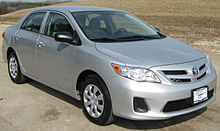
Large-scale,
As a result, Ford's cars came off the line in 15-minute intervals, much faster than previous methods, increasing productivity eightfold, while using less manpower (from 12.5 manhours to 1 hour 33 minutes).
Ford's complex safety procedures—especially assigning each worker to a specific location instead of allowing them to roam about—dramatically reduced the rate of injury.[44] The combination of high wages and high efficiency is called "Fordism" and was copied by most major industries. The efficiency gains from the assembly line also coincided with the economic rise of the US. The assembly line forced workers to work at a certain pace with very repetitive motions which led to more output per worker while other countries were using less productive methods.
In the automotive industry, its success was dominating, and quickly spread worldwide seeing the founding of Ford France and Ford Britain in 1911, Ford Denmark 1923, Ford Germany 1925; in 1921, Citroën was the first native European manufacturer to adopt the production method. Soon, companies had to have assembly lines, or risk going broke; by 1930, 250 companies which did not, had disappeared.[43]
Development of automotive technology was rapid, due in part to the hundreds of small manufacturers competing to gain the world's attention. Key developments included electric
Since the 1920s, nearly all cars have been mass-produced to meet market needs, so marketing plans often have heavily influenced car design. It was
Reflecting the rapid pace of change, makes shared parts with one another so larger production volume resulted in lower costs for each price range. For example, in the 1930s,
In Europe, much the same would happen.
In Japan, car production was very limited before World War II. Only a handful of companies were producing vehicles in limited numbers, and these were small, three-wheeled for commercial uses, like
Components and design
Propulsion and fuels
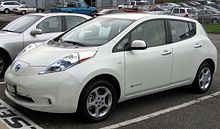
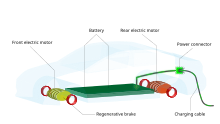
Fossil fuels
The transport sector is a major contributor to air pollution, noise pollution and climate change.[46]
Most cars in use in the early 2020s run on
Other hydrocarbon fossil fuels also burnt by
As of 2023[update] few production cars use wheel hub motors.[54][55]
Batteries
In almost all hybrid (even mild hybrid) and pure electric cars regenerative braking recovers and returns to a battery some energy which would otherwise be wasted by friction brakes getting hot.[56] Although all cars must have friction brakes (front disc brakes and either disc or drum rear brakes[57]) for emergency stops, regenerative braking improves efficiency, particularly in city driving.[58]
User interface

Cars are equipped with controls used for driving, passenger comfort, and safety, normally operated by a combination of the use of feet and hands, and occasionally by voice on 21st-century cars. These controls include a steering wheel, pedals for operating the brakes and controlling the car's speed (and, in a manual transmission car, a clutch pedal), a shift lever or stick for changing gears, and a number of buttons and dials for turning on lights, ventilation, and other functions. Modern cars' controls are now standardized, such as the location for the accelerator and brake, but this was not always the case. Controls are evolving in response to new technologies, for example, the electric car and the integration of mobile communications.
Some of the original controls are no longer required. For example, all cars once had controls for the choke valve, clutch,
Electronics and interior
Cars are typically equipped with interior lighting which can be toggled manually or be set to light up automatically with doors open, an
Lighting
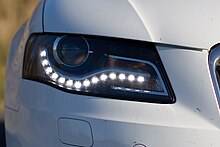
Cars are typically fitted with multiple types of lights. These include
Weight and size

During the late 20th and early 21st century, cars increased in weight due to batteries,
Some places tax heavier cars more:[68] as well as improving pedestrian safety this can encourage manufacturers to use materials such as recycled aluminium instead of steel.[69] It has been suggested that one benefit of subsidizing charging infrastructure is that cars can use lighter batteries.[70]
Seating and body style
Most cars are designed to carry multiple occupants, often with four or five seats. Cars with five seats typically seat two passengers in the front and three in the rear.
Safety

Traffic collisions are the largest cause of injury-related deaths worldwide.
Costs and benefits
The costs of car usage, which may include the cost of: acquiring the vehicle, repairs and
Similarly the costs to society of car use may include;
Environmental effects
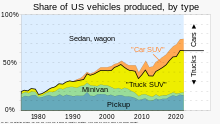
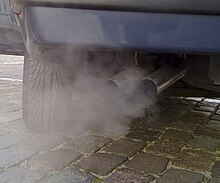
Cars are a major cause of urban
The lifetime of a car built in the 2020s is expected to be about 16 years, or about 2 millionkm (1.2 millionmiles) if driven a lot.[92] According to the International Energy Agency the average rated fuel consumption of new light-duty vehicles fell by only 0.9% between 2017 and 2019, far smaller than the 1.8% annual average reduction between 2010 and 2015. Given slow progress to date, the IEA estimates fuel consumption will have to decrease by 4.3% per year on average from 2019 to 2030.[93] The increase in sales of SUVs is bad for fuel economy.[49] Many cities in Europe have banned older fossil fuel cars and all fossil fuel vehicles will be banned in Amsterdam from 2030.[94] Many Chinese cities limit licensing of fossil fuel cars,[95] and many countries plan to stop selling them between 2025 and 2050.[96]
The manufacture of vehicles is resource intensive, and many manufacturers now report on the environmental performance of their factories, including energy usage,
Animals and plants are often negatively affected by cars via habitat destruction and pollution. Over the lifetime of the average car, the "loss of habitat potential" may be over 50,000 square metres (540,000 sq ft) based on primary production correlations.[100][clarification needed] Animals are also killed every year on roads by cars, referred to as roadkill. More recent road developments are including significant environmental mitigation in their designs, such as green bridges (designed to allow wildlife crossings) and creating wildlife corridors.
Growth in the popularity of cars and commuting has led to traffic congestion.[101] Moscow, Istanbul, Bogotá, Mexico City and São Paulo were the world's most congested cities in 2018 according to INRIX, a data analytics company.[102]
Social issues
Mass production of personal motor vehicles in the United States and other developed countries with extensive territories such as Australia, Argentina, and France vastly increased individual and group mobility and greatly increased and expanded economic development in urban, suburban, exurban and rural areas.[citation needed]
In the United States, the transport divide and car dependency resulting from domination of car-based transport systems presents barriers to employment in low-income neighbourhoods,[103] with many low-income individuals and families forced to run cars they cannot afford in order to maintain their income.[104] Dependency on automobiles by African Americans may result in exposure to the hazards of driving while black and other types of racial discrimination related to buying, financing and insuring them.[105]
Emerging car technologies
Although intensive development of conventional
New materials which may replace steel car bodies include aluminium,
Autonomous car
Fully autonomous vehicles, also known as driverless cars, already exist as robotaxis[114][115] but have a long way to go before they are in general use.[116]
Open source development
There have been several projects aiming to develop a car on the principles of
Car sharing
Car-share arrangements and carpooling are also increasingly popular, in the US and Europe.[118] For example, in the US, some car-sharing services have experienced double-digit growth in revenue and membership growth between 2006 and 2007. Services like car sharing offer residents to "share" a vehicle rather than own a car in already congested neighbourhoods.[119]
Industry
This section needs expansion. You can help by adding to it. (March 2019) |

The automotive industry designs, develops, manufactures, markets, and sells the world's motor vehicles, more than three-quarters of which are cars. In 2020, there were 56 million cars manufactured worldwide,[120] down from 67 million the previous year.[121]
The automotive industry in China produces by far the most (20 million in 2020), followed by Japan (seven million), then Germany, South Korea and India.[122] The largest market is China, followed by the US.
Around the world, there are about a billion cars on the road;[123] they burn over a trillion litres (0.26×1012 US gal; 0.22×1012 imp gal) of petrol and diesel fuel yearly, consuming about 50 exajoules (14,000 TWh) of energy.[124] The numbers of cars are increasing rapidly in China and India.[13] In the opinion of some, urban transport systems based around the car have proved unsustainable, consuming excessive energy, affecting the health of populations, and delivering a declining level of service despite increasing investment. Many of these negative effects fall disproportionately on those social groups who are also least likely to own and drive cars.[125][126] The sustainable transport movement focuses on solutions to these problems. The car industry is also facing increasing competition from the public transport sector, as some people re-evaluate their private vehicle usage.
Alternatives
Established alternatives for some aspects of car use include
See also
|
General:
|
Effects:
|
Mitigation:
|
Notes
- ^ Auxiliary power outlets may be supplied continuously or only when the ignition is active depending on electrical wiring.
References
- ISBN 978-0198611134.
- ^ a b "motor car, n." OED Online. Oxford University Press. September 2014. Archived from the original on 8 December 2014. Retrieved 29 September 2014.
- ^ "The Motor Vehicle, 1917". Scientific American. January 2017. Archived from the original on 26 October 2022. Retrieved 16 January 2023.
- www.history.com. 21 August 2018. Archivedfrom the original on 27 November 2018. Retrieved 29 August 2021.
- ^ "EV Price Parity Coming Soon, Claims VW Executive". CleanTechnica. 9 August 2019. Archived from the original on 14 September 2019. Retrieved 10 August 2019.
- ^ "Electric V Petrol". British Gas. Archived from the original on 18 October 2019. Retrieved 18 October 2019.
- ^ "Factcheck: How electric vehicles help to tackle climate change". Carbon Brief. 13 May 2019. Archived from the original on 25 August 2021. Retrieved 28 July 2020.
- ^ "Electric Cars @ProjectDrawdown #ClimateSolutions". Project Drawdown. 6 February 2020. Archived from the original on 27 November 2020. Retrieved 20 November 2020.
- ^ a b "Car Operating Costs". RACV. Archived from the original on 7 October 2009. Retrieved 22 December 2009.
- ^ ISBN 92-4-156260-9. Archivedfrom the original on 4 May 2008. Retrieved 24 June 2008.
- ^ ISBN 1-86207-698-7.
- ^ ISBN 0-8139-2266-6.
- ^ a b "Automobile Industry Introduction". Plunkett Research. Archived from the original on 22 July 2011.
- ^ "Car". (etymology). Online Etymology Dictionary. Archived from the original on 6 March 2008. Retrieved 2 June 2008.
- ^ "Wayne State University and The Detroit Public Library Present "Changing Face of the Auto Industry"". Wayne State University. 28 June 2003. Archived from the original on 28 June 2003.
- ^ "car, n.1". OED Online. Oxford University Press. September 2014. Archived from the original on 8 December 2014. Retrieved 29 September 2014.
- ^ "A dictionary of the Welsh language" (PDF). University of Wales. Archived (PDF) from the original on 6 October 2014. Retrieved 15 June 2016.
- ^ "auto-, comb. form2". OED Online. Oxford University Press. September 2014. Archived from the original on 8 December 2014. Retrieved 29 September 2014.
- ^ "Definition of horseless carriage". Merriam-Webster. Archived from the original on 13 June 2015. Retrieved 23 November 2015.
- ^ "Prospective Arrangements". The Times. 4 December 1897. p. 13.
- ^ "automobile, adj. and n." OED Online. Oxford University Press. September 2014. Archived from the original on 8 December 2014. Retrieved 29 September 2014.
- ^ "Definition of "auto"". Cambridge Dictionary. Archived from the original on 15 September 2015. Retrieved 19 August 2015.
- ^ "Definition of auto". Merriam-Webster. Archived from the original on 10 September 2015. Retrieved 23 November 2015.
- ^ Dimitris (16 July 2016). "Dimitris' Diary: Stuttgart, cradle of the automobile and the imperial family". Go Easy Berlin. Germany. Retrieved 22 November 2023.
- ^ "USAG Stuttgart". Military One Source. US. 17 August 2023. Retrieved 22 November 2023.
- ^ "1679-1681–R P Verbiest's Steam Chariot". History of the Automobile: origin to 1900. Hergé. Archived from the original on 3 March 2016. Retrieved 8 May 2009.
- ^ a b "A brief note on Ferdinand Verbiest". Curious Expeditions. 2 July 2007. Archived from the original on 10 March 2013. Retrieved 18 April 2008. – The vehicle pictured is the 20th century diecast model made by Brumm, of a later vehicle, not a model based on Verbiest's plans.
- ^ a b c "Nicolas-Joseph Cugnot". Encyclopædia Britannica. Archived from the original on 29 April 2015. Retrieved 2 June 2022.
- ^ a b speos.fr. "Niepce Museum, Other Inventions". Niepce.house.museum. Archived from the original on 20 December 2005. Retrieved 26 August 2010.
- ^ Lazarnick, Nick (30 July 1907). "Henry Ford posing in Ford-Lenoir automobile". detroit public library. Archived from the original on 20 February 2023. Retrieved 20 February 2023.
- ^ a b c Stein, Ralph (1967). The Automobile Book. Paul Hamlyn.
- ISBN 1-56091-299-5.
- ^ "1885–1886. The first automobile". Daimler. Archived from the original on 21 October 2018. Retrieved 30 July 2021.
- ISBN 978-1351440486.
- ^ "The First Car – A History of the Automobile". Ausbcomp.com. Archived from the original on 16 July 2011. Retrieved 17 July 2011.
- ^ "The Duryea Brothers – Automobile History". Inventors.about.com. 16 September 2010. Archived from the original on 10 July 2012. Retrieved 17 July 2011.
- ^ Longstreet, Stephen. A Century on Wheels: The Story of Studebaker. New York: Henry Holt. p. 121. 1st edn., 1952.
- ^ Clymer, Floyd (1950). Treasury of Early American Automobiles, 1877–1925. New York: Bonanza Books. p. 178.
- ISBN 0-600-00283-7.
- ^ ISBN 1-57958-293-1.
- ^ Jerina, Nataša G. (May 2014). "Turin Charter ratified by FIVA". TICCIH. Archived from the original on 11 March 2018. Retrieved 11 March 2018.
- ^ "Industrialization of American Society". Engr.sjsu.edu. Archived from the original on 19 September 2010. Retrieved 17 July 2011.
- ^ ISBN 1-85501-926-4.
- OCLC 913956423.
- ^ "Are Electric Vehicles Safe?". www.recurrentauto.com. Retrieved 22 January 2024.
EVs are mostly all built like a skateboard, with the battery pack on the bottom of the car. This gives them amazing cornering and handling, and makes them very hard to flip.
- ^ "Transport greenhouse gas emissions". European Environment Agency. Archived from the original on 31 March 2022. Retrieved 11 March 2019.
- ^ "14 Countries and Territory State Move Up in Top 100 Ranking on Gasoline Sulfur Limits". Stratas Advisors. 30 July 2018. Archived from the original on 15 February 2019. Retrieved 17 March 2019.
- ^ "'Among the worst in OECD': Australia's addiction to cheap, dirty petrol". The Guardian. 4 February 2019. Archived from the original on 22 March 2019. Retrieved 22 March 2019.
- ^ a b c "October: Growing preference for SUVs challenges emissions reductions in passenger car mark". IEA. Archived from the original on 18 October 2019. Retrieved 18 October 2019.
- ^ "Bloomberg NEF Electric Vehicle Outlook 2019". Bloomberg NEF. 15 May 2019. Archived from the original on 3 June 2019. Retrieved 3 June 2019.
- ^ "Govt to completely lift fuel subsidies in 2020: minister". Egypt Independent. 8 January 2019. Archived from the original on 2 February 2019. Retrieved 17 March 2019.
- ^ "Why the Rouhani administration must eliminate energy subsidies". Al-Monitor. 9 December 2018.
- ^ a b "Trends in electric light-duty vehicles – Global EV Outlook 2022 – Analysis". IEA. Archived from the original on 10 July 2022. Retrieved 7 July 2022.
- ^ "Elaphe & McLaren team up on powertrain development". Electrive. Archived from the original on 16 January 2023. Retrieved 16 January 2023.
- ^ Muller, Joann (11 January 2023). "Axios auto expert's picks for best vehicles of the year". Axios. Archived from the original on 16 January 2023. Retrieved 16 January 2023.
- ^ Cline, Amanda (25 December 2021). "What Is a Mild Hybrid Vehicle?". MotorBiscuit. Archived from the original on 16 January 2023. Retrieved 16 January 2023.
- ^ "Why Drum Brakes Works on EVs". Benevelli. Archived from the original on 16 January 2023. Retrieved 16 January 2023.
- ^ "Regenerative Braking: Benefits and Limitations". The Brake Report. 31 May 2022. Archived from the original on 16 January 2023. Retrieved 16 January 2023.
- ^ "VW Golf: Innenleuchten" (in German). Archived from the original on 25 October 2021. Retrieved 26 October 2021.
- ^ "[…] Kühlboxen im Test […]". auto motor und sport (in German). 24 May 2017. Archived from the original on 26 October 2021. Retrieved 26 October 2021.
- ^ "Alle Infos von der neuen Mercedes S-Klasse 2013 (W222)". auto.oe24.at (in German). 16 May 2013. Archived from the original on 26 October 2021. Retrieved 26 October 2021.
- ^ "Mercedes-Benz S-Klasse 2013: Alle Details und Fotos des neuen Alphatiers". Speed Heads (in German). 2013. Archived from the original on 26 October 2021. Retrieved 26 October 2021.
- ^ "Used 2008 Chevrolet Suburban Features & Specs". Edmunds. Archived from the original on 25 November 2015. Retrieved 25 November 2015.
- ^ "How much do electric cars weigh?". EV Archive. Archived from the original on 16 July 2019. Retrieved 1 December 2019.
- ^ a b Lowrey, Annie (27 June 2011). "Your Big Car Is Killing Me". Slate. Archived from the original on 25 November 2015. Retrieved 25 November 2015.
- ^ Sellén, Magnus (2 August 2019). "How much does a Car Weigh? – [Weight List by Car Model & Type]". Mechanic Base. Archived from the original on 22 December 2019. Retrieved 1 December 2019.
- ISSN 0261-3077. Retrieved 22 January 2024.
- ISSN 0261-3077. Retrieved 22 January 2024.
France has …. penalties that cover the weight of a car.
- from the original on 14 October 2021. Retrieved 15 October 2021.
- ^ "How big a battery should you insist on for your electric car?". thestar.com. 9 April 2022. Archived from the original on 2 October 2022. Retrieved 2 October 2022.
- ^ "Mary Ward 1827–1869". Universityscience.ie. Archived from the original on 11 March 2008. Retrieved 27 October 2008.
- ^ "Bliss plaque". CityStreets. Archived from the original on 26 August 2006.
- ^ "SaferCar.gov". NHTSA. Archived from the original on 27 July 2004.
- ^ "IIHS-HLDI". IIHS-HLDI crash testing and highway safety. Archived from the original on 23 January 2018. Retrieved 1 December 2022.
- ^ Fran Tonkiss (2005). Space, the city and social theory: social relations and urban forms. Polity.
- ^ "Ford's Affordable EV Charger Will Let an F-150 Power Your Home". Review Geek. March 2022. Archived from the original on 7 March 2022. Retrieved 7 March 2022.
- The Huffington Post. Archivedfrom the original on 20 November 2015. Retrieved 23 November 2015.
- ^ "Highlights of the Automotive Trends Report". EPA.gov. U.S. Environmental Protection Agency (EPA). 12 December 2022. Archived from the original on 2 September 2023.
- doi:10.7922/G2HM56SV. Archived(PDF) from the original on 26 November 2023.
- from the original on 4 December 2019. Retrieved 1 December 2019.
- ^ Carroll, Sean Goulding (9 May 2022). "Switch to EVs won't solve 'road dust' pollution – in fact, it could make it worse". www.euractiv.com. Archived from the original on 17 November 2022. Retrieved 17 November 2022.
- ^ "Tough Euro 7 pollution rules planned for adoption this month". Automotive News Europe. 10 October 2022. Archived from the original on 24 October 2022. Retrieved 24 October 2022.
- ^ "EEA report confirms: electric cars are better for climate and air quality". European Environment Agency. Archived from the original on 3 December 2019. Retrieved 1 December 2019.
- ^ "Cars and Vans – Analysis". IEA. Archived from the original on 17 November 2022. Retrieved 17 November 2022.
- .
- ^ "Carbon footprint report: Volvo C40 Recharge" (PDF). Archived (PDF) from the original on 13 July 2022. Retrieved 24 October 2022.
- ^ "How much CO2 can electric cars really save?". Transport & Environment. 30 May 2022. Archived from the original on 15 September 2021. Retrieved 24 October 2022.
- ^ "Electric Vehicles". carbonfootprint.com. Archived from the original on 21 April 2020. Retrieved 1 December 2019.
- ^ Hoekstra, Auke (3 November 2019). "Tomorrow is Good: why German automobile club study is the anti-electric lobby at its finest". Innovation Origins. Archived from the original on 14 December 2019. Retrieved 1 December 2019.
- ^ "A Review and Comparative Analysis of Fiscal Policies Associated with New Passenger Vehicle CO2 Emissions" (PDF). International Council on Clean Transportation. February 2011. Archived (PDF) from the original on 8 March 2021. Retrieved 15 October 2013.
- ^ from the original on 26 January 2020. Retrieved 26 January 2020.
- ^ "Tesla supplier ready to make million-mile battery". BBC News. 8 June 2020. Archived from the original on 9 June 2020. Retrieved 9 June 2020.
- ^ "Global Fuel Economy Initiative 2021". International Energy Agency. Paris. Archived from the original on 6 March 2023. Retrieved 6 March 2023.
- from the original on 7 September 2020. Retrieved 18 May 2019.
- ^ Lambert, Fred (6 June 2019). "China boosts electric car sales by removing license plate quotas". Electrek. Archived from the original on 8 November 2019. Retrieved 11 June 2019.
- ^ Carroll, Sean Goulding (5 July 2022). "A seismic shift: Support for ICE melts as Europe warms to EVs". www.euractiv.com. Archived from the original on 7 July 2022. Retrieved 7 July 2022.
- ^ "Volvo's carbon-free car factory". Ends Report. October 2005. Archived from the original on 19 August 2014. Retrieved 15 October 2013.
- ^ Group, Drax. "Drax Electric Insights". Drax Electric Insights. Archived from the original on 10 October 2020. Retrieved 12 September 2019.
- ^ "Our Ailing Communities". Metropolis Magazine. Archived from the original on 8 February 2007.
- ^ Ball, Jeffrey (9 March 2009). "Six Products, Six Carbon Footprints". The Wall Street Journal. Archived from the original on 6 December 2010. Retrieved 10 January 2011.
- ^ "Planning and the Complicated Causes and Effects of Congestion". www.planetizen.com. Archived from the original on 24 October 2022. Retrieved 24 October 2022.
- ^ Newman, Katelyn (12 February 2019). "Cities With the World's Worst Traffic Congestion". US News. Archived from the original on 18 March 2019. Retrieved 16 March 2019.
- ^ "Tackling transport-related barriers to employment in low-income neighbourhoods". JRF. 6 August 2018. Archived from the original on 13 April 2021. Retrieved 13 April 2021.
- .
- ^ Andrew Ross; Julie Livingston (15 December 2022). "Once You See the Truth About Cars, You Can't Unsee It". The New York Times. No. New York Times. Archived from the original on 15 December 2022. Retrieved 16 December 2022.
Andrew Ross and Julie Livingston are New York University professors, members of NYU's Prison Education Program Research Lab and authors of the book "Cars and Jails: Freedom Dreams, Debt, and Carcerality."
- ^ "EV battery research projects get £55m funding boost". Air Quality News. 5 September 2019. Archived from the original on 5 September 2019. Retrieved 5 September 2019.
- ^ "Wireless electric car charging gets cash boost". 9 July 2019. Archived from the original on 9 December 2019. Retrieved 3 January 2020.
- ^ "China's Hydrogen Vehicle Dream Chased With $17 Billion of Funding". 23 July 2019. Archived from the original on 21 July 2019. Retrieved 23 July 2019.
- ^ "Motor Mouth: Is Mazda's e-TPV the perfect electric vehicle?". Driving. 3 September 2019. Archived from the original on 5 September 2019. Retrieved 5 September 2019.
- ^ "Ammonia for fuel cells". phys.org. Archived from the original on 5 September 2019. Retrieved 5 September 2019.
- ^ "Survey reveals aluminum remains fastest growing automotive material". Automotive World. 12 August 2020. Archived from the original on 21 October 2021. Retrieved 15 October 2021.
- ^ Vyas, Kashyap (3 October 2018). "This New Material Can Transform the Car Manufacturing Industry". Interesting Engineering. Turkey. Archived from the original on 16 September 2019. Retrieved 16 March 2019.
- ^ "Inside Uniti's plan to build the iPhone of EVs". GreenMotor.co.uk. Archived from the original on 3 July 2017. Retrieved 26 June 2017.
- ^ "China's Xpeng passes autonomous driving test in race to launch robotaxis". South China Morning Post. 25 October 2022. Archived from the original on 24 October 2022. Retrieved 24 October 2022.
- ^ "8 Ways Waymo's Autonomous Taxi Surprised Us on a Ride". Consumer Reports. 4 October 2022. Archived from the original on 24 October 2022. Retrieved 24 October 2022.
- from the original on 2 September 2021. Retrieved 2 September 2021.
- ^ "Geek My Ride presentation at linux.conf.au 2009". Archived from the original on 11 April 2011. Retrieved 11 July 2010.
- ^ "Global Automotive Consumer Study – exploring consumer preferences and mobility choices in Europe" (PDF). Deloitte. 2014. Archived from the original (PDF) on 4 July 2015. Retrieved 23 November 2015.
- ^ "Flexcar Expands to Philadelphia". Green Car Congress. 2 April 2007. Archived from the original on 9 July 2007. Retrieved 12 April 2007.
- ^ "2020 Statistics". OICA. Archived from the original on 2 April 2022. Retrieved 2 September 2021.
- ^ "2019 Statistics". OICA. Archived from the original on 20 November 2021. Retrieved 2 September 2021.
- ^ "2018 Statistics". OICA. Archived from the original on 19 September 2021. Retrieved 24 September 2021.
- ^ "PC World Vehicles in Use" (PDF). OICA. Archived (PDF) from the original on 23 September 2021. Retrieved 16 March 2019.
- ^ "Global Transportation Energy Consumption: Examination of Scenarios to 2040 using ITEDD" (PDF). Energy Information Administration. Archived (PDF) from the original on 11 May 2019. Retrieved 16 March 2019.
- ^ World Health Organisation, Europe. "Health effects of transport". Archived from the original on 29 May 2011. Retrieved 29 August 2008.
{{cite web}}: CS1 maint: numeric names: authors list (link) - ^ "Global Action for Healthy Streets: Annual Report 2018" (PDF). FiA Foundation. Retrieved 16 March 2019.[permanent dead link]
- ^ "About Bike Share Programs". Tech Bikes MIT. Archived from the original on 20 December 2007. Retrieved 17 August 2019.
- ^ Cambell, Charlie (2 April 2018). "The Trouble with Sharing: China's Bike Fever Has Reached Saturation Point". Time. Archived from the original on 7 June 2019. Retrieved 18 August 2019.
- ISBN 0-520-21620-2.
- ^ Walker, Peter (8 March 2024). "Health gains of low-traffic schemes up to 100 times greater than costs, study finds". The Guardian. Retrieved 10 March 2024.
Further reading
- ISBN 0-688-04838-2.
- Kay, Jane Holtz (1997). Asphalt nation : how the automobile took over America, and how we can take it back. New York: Crown. ISBN 0-517-58702-5.
- ISBN 1-55970-176-5.
- ISBN 0-520-06878-5.
- Margolius, Ivan (2020). "What is an automobile?". The Automobile. 37 (11): 48–52. ISSN 0955-1328.
- Cole, John; Cole, Francis (213). A Geography of the European Union. London: Routledge. p. 110. ISBN 9781317835585. – Number of cars in use (in millions) in various European countries in 1973 and 1992
- Latin America: Economic Growth Trends. US: Agency for International Development, Office of Statistics and Reports. 1972. p. 11. – Number of motor vehicles registered in Latin America in 1970
- World Motor Vehicle Production and Registration. US: Business and Defense Services Administration, Transportation Equipment Division. p. 3. – Number of registered passenger cars in various countries in 1959-60 and 1969-70
External links
 Media related to Automobiles at Wikimedia Commons
Media related to Automobiles at Wikimedia Commons- Fédération Internationale de l'Automobile
- Forum for the Automobile and Society
- Transportation Statistics Annual Report 1996: Transportation and the Environment by Fletcher, Wendell; Sedor, Joanne; p. 219 (contains figures on vehicle registrations in various countries in 1970 and 1992)

